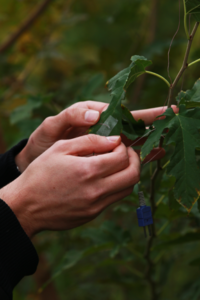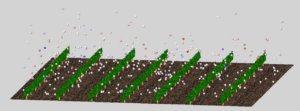“Dive in headfirst,” says University of Utah mechanical engineering Ph.D. candidate Brian Bailey ’15. “One of the things that has helped me to be a successful student and researcher is to not get intimidated or overwhelmed whenever I came across something I didn’t understand or couldn’t figure out. Learn a little more each day. Before you know it, you’ll be an expert.”
Growing up in the Salt Lake City area, Bailey never questioned getting his B.S. from anywhere other than the U. Deciding on a major was less clear. Math, science or engineering were not his first choices. That was before one of his co-workers, a U mechanical engineering student, started talking about his experiences. Intrigued by the challenge, the rest is history.

“During my junior year, I was invited to work in mechanical engineering assistant professor Rob Stoll’s lab developing a fluid simulation code. The simulation was to efficiently exploit the performance capabilities of today’s supercomputing systems,” says Bailey. “One of my major challenges was learning computer science, engineering and the atmospheric sciences.”
Before Bailey knew it, he was hooked on research and went for a B.S./M.S degree under Dr. Stoll. His master’s project was examining how infectious diseases are spread through the air in agricultural canopies. “This was a meaningful project,” says Bailey, “because it was information growers needed on best practices to limit the airborne pathogens compromising our food supply.”
Going for a Ph.D. was a hard decision, but a decision Bailey does not regret. In fact he has now chosen research as his career choice. “I love the freedom and creativity associated with the research environment.” Bailey notes, “What could be better than getting paid to learn for a living?”

For his Ph.D. project, Bailey’s research predicts leaf temperature in complex plant canopies. Leaf temperature plays a critical role in nearly all biological processes in plant canopies (e.g., growth, photosynthesis and spread of disease).
“I have had the great fortune at the U to work simultaneously on several independent projects. This is somewhat unusual for a Ph.D. student and has allowed me to widely broaden the scope of my work,” explains Bailey. Understanding these processes is a necessary part of building a sustainable society, which can be created through green infrastructure, securing the food supply, and understanding the effects of climate change.”

“Using state-of-the-art simulation techniques we are able to understand how canopy geometry shapes the underlying structure of the turbulent wind field, and ultimately the mechanisms that affect the transport of heat, water, gasses, and particulates through the air,” says Bailey.
Away from research, Brian stays in shape by playing in an ice hockey league. When there’s spare time, he enjoys expressing his creativity through oil painting.
The Department of Mechanical Engineering at the University of Utah is committed to providing students with broad-based, rigorous and progressive education. By combining state-of-the-art facilities with renowned faculty, the department provides an education that gives students the necessary skills to become the next generation of innovators.